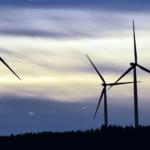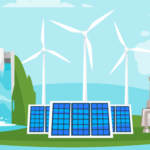Did you know that Guatemala is the second largest energy market in Central America? The country has a generation capacity of 3.7 GW. The energy is connected to Honduras and El Salvador through the Central American Electric Integration System (SIEPAC). Northern Guatemala is also connected to Mexico’s transmission system (Sopelia, 2017).
The Ministry of Energy and Mines oversees the planning of the electricity sector, while the National Electricity Commission (CNEE) is responsible for regulation. In addition, the Wholesale Market Administrator organizes the dispatch of the system.
The energy market in Guatemala also has state and private actors involved in generation, transmission, trading and distribution. The country conducts auctions to award electricity production contracts, in which renewable energies can have a specific quota or compete with other technologies. These auctions have been the main driver of investment in renewable energy (Sopelia, 2017).
Most used energy sources in Guatemala
In the country, primary sources are mostly derived from oil and hydroelectric power plants. Among them, the main ones are: bunker, diesel, hydroelectric, geothermal, coal and biomass (Mundo Chapín, 2018b).
The most commonly used fuel is coal, followed by bunker and, to a lesser extent, diesel (Incyt, 2018). Generating companies in Guatemala include PQP (Puerto Quetzal Power), Duke Energy and Inde Guatemala (Pulso Capital, 2021).
Hydroelectric power
Electricity generation in Guatemala began in 1884, when the first hydroelectric plant was installed on the El Zapote farm, north of the capital, with the capacity to light 135 lamps. In 2018, in hydroelectric power plants connected to the National Interconnected System (NIS), a total effective installed capacity of 1,444.27 MW was reached (MEM, 2019).
Geothermal energy
It consists of porous and permeable rock reservoirs in which, by circulation of steam or hot water, a convection system develops. Groundwater seeps to depths of several kilometers, where it is heated directly or indirectly by the magma. Thus, it expands and rises to the surface, at elevated temperature, in liquid or vapor form, as geysers or hot springs. This resource is found near places where there is volcanic activity or tectonic plate movement.
In Guatemala there are two geothermal power plants connected to the National Interconnected System with an effective installed capacity of 35.23 MW. One in the municipality of Zunil, department of Quetzaltenango, and the other in San Vicente Pacaya (Escuintla). This resource is also used in thermal baths in Quetzaltenango, Chiquimula, Santa Rosa, El Progreso, Jalapa, Totonicapán and Quiché (MEM, 2019).
Changes in the energy system
The country’s situation has evolved and undergone major changes in recent years.
2003
The Law of Incentives for Renewable Energy Generation was approved.
2005
Tax incentives were established for 10 years. These included import tax exemptions for materials for electricity generation projects from a renewable source.
2010
The Indicative Expansion Plan for the PEG-1 Generation System was launched. Its goal is that by 2022 at least 60 % of energy will be produced from renewable resources.
2012
The CNEE began holding tenders: the first one awarded 393 MW to small hydro, wind, solar and biomass plants. With 15-year purchase contracts.
2014
The second tender sought to contract 250 MW. With a total of U$D 702 million, that year there was record investment in biomass, solar, hydroelectric and wind power plants.
2015
The first auctioned projects started to connect to the grid, but investments declined. 10.3 TWh of electricity were generated. Of these, 46% came from fossil fuels, 26% from hydroelectric and 28% from renewables. The installed capacity of the latter increased 38 % (reaching 1 GW). The price of retail electricity fell 21%.
2017
A tender was prepared for 420 MW for a period of 15 years (Sopelia, 2017).
2018
Guatemala was one of the countries that exported the most to the Regional Electricity Market, but at the end of that year these transactions decreased.
2019 y 2020
Exports continued their downward trend. Among other things, because four solar plants and a wind project were installed in El Salvador (one of the largest buyers). Also, two solar plants and two bunker plants in Honduras and two solar projects in Panama. In the medium term, Guatemala’s export exchanges with the Regional Electricity Market could continue to decrease (AMM, 2021).
Guatemala’s main energy challenge: environmental sustainability
Guatemala is in a strategic position to take advantage of renewable natural resources. In addition, there are incentives to develop renewable energy projects in the investment, implementation and operation periods (Mundo Chapín, 2018a).
The current process, supported by technological innovation, aims at sustainable development. The Ministry of Energy and Mines, with its Energy Policy, promotes investment in renewable energy projects. This diversifies the electricity generation matrix and stabilizes electricity prices in the medium and long term. It does so through a law establishing fiscal, economic and administrative incentives (tax exemption) (MEM, 2019).
As we said, Guatemala has a considerable amount of renewable energy resources, which have been little exploited. Specifically:
- There is a potential of 6,000 MW of hydroelectric and 1,000 MW of geothermal, but only 24.1% and 3.5%, respectively, are used.
- In order to develop solar projects, we have an average annual global solar radiation value of 5.3 kWh/m2/day.
- There are sites to develop wind power generation projects (MEM, 2019).
In addition, garbage is an energy source that has not yet been explored. There are several landfills in Guatemala whose waste could be used to generate energy. Regardless of economic and social constraints, there are sufficient renewable energy resources for long-term use (Chapin World, 2018b).
It is convenient to finish this energy profile of Guatemala, counting that in 2027 it is expected that 80% of the energy will be from renewable sources (AGER, 2021). Undoubtedly, this is a very hopeful challenge, because it will serve to care for the environment and improve the quality of life.






